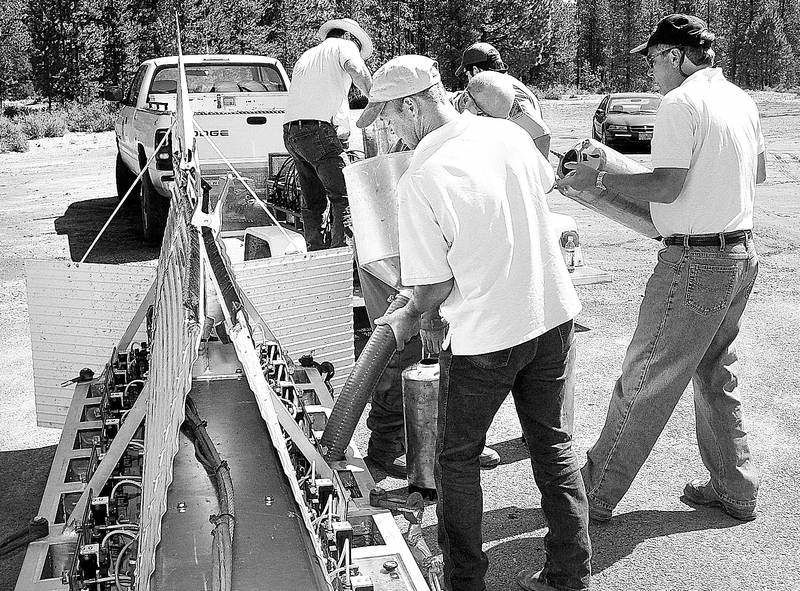Fish from up high
Published 5:00 am Thursday, August 2, 2007

- ODFW employees Kurt Cundiff, center, and Roger Smith, right, load juvenile trout into the air-stocking device, from which the trout were dropped into backcountry lakes from a helicopter last week.
Fishing a backcountry lake high in the Cascade Mountains offers a chance to escape from the hectic, high-tech world.
But advanced technology might well have helped put those fish in that out-of-the-way lake.
On alternating years, the Oregon Department of Fish and Wildlife uses a helicopter and an air-stocking device to stock backcountry lakes with fish.
Last week, biologists dropped more than 300,000 rainbow, cutthroat and brook trout into about 450 lakes in the Cascade Mountains of Oregon.
Ted Wise, an ODFW fisheries biologist based in Bend, oversees the air-stocking operation and serves as a navigator in the helicopter.
“We stock a lot of lakes here in Central Oregon,” Wise says. “A lot of small, backcountry lakes. Just little guys that you can’t drive to. A lot of them are unknown, with people backpacking, who want to camp.”
Last week, fisheries biologists from seven different ODFW districts began stocking lakes near Mount Hood in the northern part of the state, then flew south to stock lakes near Mount Jefferson. From there, they continued south to Fall River Fish Hatchery, where they picked up fish to stock in small lakes from near Broken Top south to the Diamond Peak area.
The fish are relatively small — just 1½ to two inches long — so they can survive the impact with the water from 100 feet, according to Wise. But some can grow to eight inches long within a few years, Wise says.
“It’s a very sufficient operation,” Wise says. “Our survival rate is very high.”
The operation starts from a hatchery or other staging area, where juvenile trout are pre-loaded into oxygenated water containers. They are then transferred into the air-stocking device, a large aluminum case that resembles a small space shuttle and hangs from a long-line cable nearly 60 feet below the helicopter.
In the device, which weighs nearly 1,000 pounds, fish are stored in 30 separate oxygenated water compartments, each of which holds up to 1,000 fish. With the press of a button, the fish are released from specific compartments for specific lakes.
The button opens a two-inch-wide retractable plunger, dropping the fish into the lakes.
A district fish biologist provides navigation (with a Global Positioning System) for the helicopter pilot while another biologist uses a control panel to release fish into the lakes at the appropriate time.
According to Wise, the air-stocking program began in the 1950s, when officials used an airplane to stock the high lakes. That process, Wise recalls, took several weeks. The switch to helicopter drops was made in 1981. The current air-stocking device was first used in 1997, and now biologists can stock 450 lakes in one week, and 90 lakes in one day, Wise says.
This year, the fish biologists used new navigation software and hardware that provided more efficient flight times. The air-stocking program is the most cost-effective program in the state, according to Wise.
“We do a lot of lakes in a short period of time,” Wise says. “It’s much more efficient. And there’s more use of those lakes than people might imagine.”
Lakes stocked from the air last week near Mount Jefferson included Wasco, Koko, Booth, Martin, Square and Long.
Doris and Blow lakes, west of Cultus Lake, were stocked from the helicopter, as well as Golden, Rim and South Green lakes near Broken Top.
Wise says he helped stock 107 backcountry lakes in his High Desert district, from Mount Jefferson south to Diamond Peak. But, he adds, there still are hundreds of backcountry lakes that the ODFW does not stock.
Biologists usually stock the high-elevation lakes in mid to late July, when ice and snow have sufficiently melted.
Stocking at some of these backcountry lakes began in the 1930s and ‘40s, Wise says, when the lakes were reached by horseback or mule.
Many of the lakes never even contained fish until they were stocked, according to Wise.
Now, some of the lakes receive plenty of angling pressure, but others remain relatively unknown.
“Some of them get fished pretty hard,” Wise says. “But it’s hard for us to get reports from out there. We get feedback from anglers who have been backpacking.”






